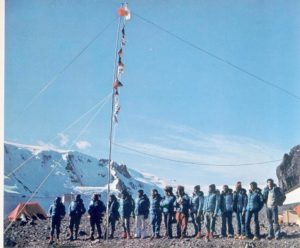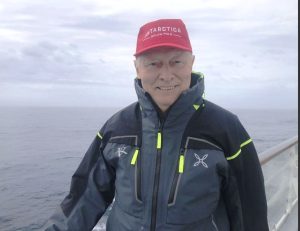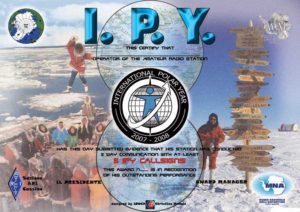For more than 20 years, Prof. Julius Fabbri has tried to gain international recognition of a time 49 years ago when an Italian private expedition built a Scientific Base in Antarctica.
 I
I n late 1975, the Italian explorer Renato Cepparo and his 14 crew members were about to embark on a private expedition to Antarctica. The expedition had been given a clearance by the Antarctic Treaty System, and the crew members were prepared to establish Italy’s very first Base in Antarctica.
n late 1975, the Italian explorer Renato Cepparo and his 14 crew members were about to embark on a private expedition to Antarctica. The expedition had been given a clearance by the Antarctic Treaty System, and the crew members were prepared to establish Italy’s very first Base in Antarctica.
Unfortunately, a few days before they were set to sail out from Montevideo, Uruguay, Cepparo received a letter from the Argentinean government. The letter informed him that Argentina had exercised a veto, and that Italy was no longer allowed to construct their base on the southern continent. Cepparo and his crew, though, were sure that they had their authorization in order, so they decided to start their expedition as planned.
The story is very long and WAP will not enter now into details, but the facts remain and make the whole story paradoxical. For sure everything is well known by the Argentine authorities who, with a gesture of sincere friendship and transparency could make it public!

 After many vicissitudes, Cepparo’s expedition landed in Antarctica and the Base, was built, this is a fact. The Giacomo Bove Station, named after a 19th century Italian explorer, was inaugurated on January 20th, 1976.
After many vicissitudes, Cepparo’s expedition landed in Antarctica and the Base, was built, this is a fact. The Giacomo Bove Station, named after a 19th century Italian explorer, was inaugurated on January 20th, 1976.
Ham radio was performed at Giacomo Bove Camp as well, with the callsign I1SR/p (WAP ITA-Ø2) and QSL card to confirm the contacts, have been printed and sent.
 The evidence says that Argentina did destroy Giacomo Bove Station when in September of 1976, they sent an icebreaker to the South Shetland Islands to tear down the newly inaugurated Base. In the middle of the Antarctic winter, the Argentians did take the Base off in the same time it had taken to construct: three to four days. The materials, which had just arrived in Antarctica, were transported back to Buenos Aires. Prof. Fabbri strongly believe that, some if it, either hidden or forgotten, is still stored in a military facility in the Argentinian capital.
The evidence says that Argentina did destroy Giacomo Bove Station when in September of 1976, they sent an icebreaker to the South Shetland Islands to tear down the newly inaugurated Base. In the middle of the Antarctic winter, the Argentians did take the Base off in the same time it had taken to construct: three to four days. The materials, which had just arrived in Antarctica, were transported back to Buenos Aires. Prof. Fabbri strongly believe that, some if it, either hidden or forgotten, is still stored in a military facility in the Argentinian capital.
«I hope someone will tell the world where they are. It’s a mystery, no one wants to remember this cold case which I have been trying to open since 2003», Prof. Julius Fabbri said.
 As a day job, Julius Fabbri (IV3CCT-II3BOVE) teaches science at a high school in Trieste, a city in northeastern Italy, but since he was young his hobby has been to be a radio operator. And in the Italian hobbyist radio operator community the story of Renato Cepparo’s Antarctic mission, a story that is otherwise not well-known, has become legendary.
As a day job, Julius Fabbri (IV3CCT-II3BOVE) teaches science at a high school in Trieste, a city in northeastern Italy, but since he was young his hobby has been to be a radio operator. And in the Italian hobbyist radio operator community the story of Renato Cepparo’s Antarctic mission, a story that is otherwise not well-known, has become legendary.
Prof. Julius Fabbri himself first heard about it in 2003 when he made his first and only trip to Antarctica. While there, a colleague told him about it, and since then he has been researching the incident passionately and, some would say, obsessively.
 Back in 2008, for instance, as a project in his science class, Prof. Fabbri and his students built a full-scale model of the ruins of Giacomo Bove Base, and a few years later, he helped design a virtual 3D model of it.
Back in 2008, for instance, as a project in his science class, Prof. Fabbri and his students built a full-scale model of the ruins of Giacomo Bove Base, and a few years later, he helped design a virtual 3D model of it.
.
.
«Most people just laugh when I tell them what I know; they don’t believe its a true story, but there are official documents, publications and articles that confirm it, and I even met one of the mariners from the Argentinean navy who wrote a detailed account of this diplomatic incident,” Julius Fabbri says.
 Next Saturday, October 5th, in the wonderful and famous setting of the city of Sanremo, Liguria Region on the Italian Riviera, the local Amateur Radio Club has organized a DX Meeting where, in addition to various technical topics relating to the world of radio, a special section is dedicated to Antarctica.
Next Saturday, October 5th, in the wonderful and famous setting of the city of Sanremo, Liguria Region on the Italian Riviera, the local Amateur Radio Club has organized a DX Meeting where, in addition to various technical topics relating to the world of radio, a special section is dedicated to Antarctica.
 This year, is quite possible that Danilo IAØ/IZ1KHY will work again in tandem with his friend David Brunet FT4YM who will be in Antarctica as well in the same period.
This year, is quite possible that Danilo IAØ/IZ1KHY will work again in tandem with his friend David Brunet FT4YM who will be in Antarctica as well in the same period.
 The objective was to support the actions aimed at crossing the Antarctic below the Antarctic Circle, at the height of the Argentine Base San Martin, and also to annually install a scientific shelter so that it could be used by the members of that Polar exploration. A snowmobile provided by Tierra del Fuego (
The objective was to support the actions aimed at crossing the Antarctic below the Antarctic Circle, at the height of the Argentine Base San Martin, and also to annually install a scientific shelter so that it could be used by the members of that Polar exploration. A snowmobile provided by Tierra del Fuego ( In the following years, the construction of new shelters in homage to other native peoples of Tierra del Fuego would continue. (
In the following years, the construction of new shelters in homage to other native peoples of Tierra del Fuego would continue. ( This week, our friend and
This week, our friend and  Why an International Polar Year in 2032–33?
Why an International Polar Year in 2032–33? The
The  I
I n late 1975, the Italian explorer Renato Cepparo and his 14 crew members were about to embark on a private expedition to Antarctica. The expedition had been given a clearance by the Antarctic Treaty System, and the crew members were prepared to establish Italy’s very first Base in Antarctica.
n late 1975, the Italian explorer Renato Cepparo and his 14 crew members were about to embark on a private expedition to Antarctica. The expedition had been given a clearance by the Antarctic Treaty System, and the crew members were prepared to establish Italy’s very first Base in Antarctica.
 After many vicissitudes, Cepparo’s expedition landed in Antarctica and the Base, was built, this is a fact. The Giacomo Bove Station, named after a 19th century Italian explorer, was inaugurated on January 20th, 1976.
After many vicissitudes, Cepparo’s expedition landed in Antarctica and the Base, was built, this is a fact. The Giacomo Bove Station, named after a 19th century Italian explorer, was inaugurated on January 20th, 1976. The evidence says that Argentina did destroy Giacomo Bove Station when in September of 1976, they sent an icebreaker to the South Shetland Islands to tear down the newly inaugurated Base. In the middle of the Antarctic winter, the Argentians did take the Base off in the same time it had taken to construct: three to four days. The materials, which had just arrived in Antarctica, were transported back to Buenos Aires. Prof. Fabbri strongly believe that, some if it, either hidden or forgotten, is still stored in a military facility in the Argentinian capital.
The evidence says that Argentina did destroy Giacomo Bove Station when in September of 1976, they sent an icebreaker to the South Shetland Islands to tear down the newly inaugurated Base. In the middle of the Antarctic winter, the Argentians did take the Base off in the same time it had taken to construct: three to four days. The materials, which had just arrived in Antarctica, were transported back to Buenos Aires. Prof. Fabbri strongly believe that, some if it, either hidden or forgotten, is still stored in a military facility in the Argentinian capital. As a day job, Julius Fabbri (IV3CCT-II3BOVE) teaches science at a high school in Trieste, a city in northeastern Italy, but since he was young his hobby has been to be a radio operator. And in the Italian hobbyist radio operator community the story of Renato Cepparo’s Antarctic mission, a story that is otherwise not well-known, has become legendary.
As a day job, Julius Fabbri (IV3CCT-II3BOVE) teaches science at a high school in Trieste, a city in northeastern Italy, but since he was young his hobby has been to be a radio operator. And in the Italian hobbyist radio operator community the story of Renato Cepparo’s Antarctic mission, a story that is otherwise not well-known, has become legendary. Back in 2008, for instance, as a project in his science class, Prof. Fabbri and his students built a full-scale model of the ruins of Giacomo Bove Base, and a few years later, he helped design a virtual 3D model of it.
Back in 2008, for instance, as a project in his science class, Prof. Fabbri and his students built a full-scale model of the ruins of Giacomo Bove Base, and a few years later, he helped design a virtual 3D model of it. The first days of spring in the Antarctic: for over a month, the island of Galindez has been almost completely packed with ice
The first days of spring in the Antarctic: for over a month, the island of Galindez has been almost completely packed with ice Sea ice plays an important role in the Antarctic ecosystem. It acts as a “blanket” that separates the ocean from the atmosphere. In addition to blocking sunlight from entering the water and reflecting it, the ice also traps the heat in the ocean, preventing it from heating the air.
Sea ice plays an important role in the Antarctic ecosystem. It acts as a “blanket” that separates the ocean from the atmosphere. In addition to blocking sunlight from entering the water and reflecting it, the ice also traps the heat in the ocean, preventing it from heating the air. A mid-July, minor Sudden Stratospheric Warming event saw the vortex become elongated, weaker, wobbly. This stratospheric anomaly affected tropospheric weather patterns, but now appears to be easing. In late July and early August, a rapid stratosphere-troposphere coupling contributed to the development of a major high pressure cell and heatwave over Antarctica, while a very deep low formed over the Southern Ocean, and a heat dome affected Australia. It was associated with relatively cool conditons in Chile and Argentina.
A mid-July, minor Sudden Stratospheric Warming event saw the vortex become elongated, weaker, wobbly. This stratospheric anomaly affected tropospheric weather patterns, but now appears to be easing. In late July and early August, a rapid stratosphere-troposphere coupling contributed to the development of a major high pressure cell and heatwave over Antarctica, while a very deep low formed over the Southern Ocean, and a heat dome affected Australia. It was associated with relatively cool conditons in Chile and Argentina. East Base,
East Base,  East Base was established in 1939 by the U.S. Antarctic Service Expedition, constructed in 1940 and occupied by them from 1940 to 1941. Later it was reoccupied in 1947-48 by the private Finn Ronne Antarctic Expedition. This marked a period of cooperation between the American and British stations, according to the history told by the British.
East Base was established in 1939 by the U.S. Antarctic Service Expedition, constructed in 1940 and occupied by them from 1940 to 1941. Later it was reoccupied in 1947-48 by the private Finn Ronne Antarctic Expedition. This marked a period of cooperation between the American and British stations, according to the history told by the British.  The Antarctic Service Expedition was the first government-funded expedition of Admiral Richard E. Byrd (his first two expeditions in 1928–1930 and 1933–1935 were privately funded). East Base was built using Army knockdown buildings and a crew of 23 led by Richard Black, after Admiral Byrd had to return to Washington on the USS Bear.
The Antarctic Service Expedition was the first government-funded expedition of Admiral Richard E. Byrd (his first two expeditions in 1928–1930 and 1933–1935 were privately funded). East Base was built using Army knockdown buildings and a crew of 23 led by Richard Black, after Admiral Byrd had to return to Washington on the USS Bear. The war time pressures and pack-ice in the bay which prevented ship movement led to the evacuation of the base in 1941 by air. Admiral Richard Byrd’s USAS Expedition built America’s earliest remaining Antarctic camp in March 1940; 4 prefabricated structures were built on: Main Building, Science Building, Machine Shop, and Outpost Hut , from which they explored and mapped Alexander Island, George VI Sound, and hundreds of miles of coastline.
The war time pressures and pack-ice in the bay which prevented ship movement led to the evacuation of the base in 1941 by air. Admiral Richard Byrd’s USAS Expedition built America’s earliest remaining Antarctic camp in March 1940; 4 prefabricated structures were built on: Main Building, Science Building, Machine Shop, and Outpost Hut , from which they explored and mapped Alexander Island, George VI Sound, and hundreds of miles of coastline.
